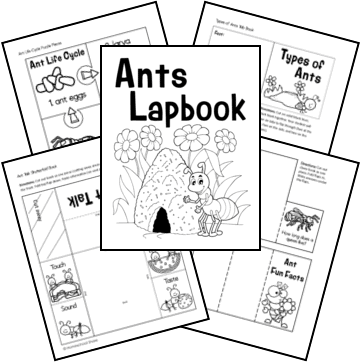Affiliate Disclaimer
We sometimes use affiliate links in our content. This won’t cost you anything, but it helps us to keep the site running. Thanks for your support.
Praying Mantises are fascinating creatures. My son found one in the yard when he was in elementary school, and we brought it in and observed it for about a week before releasing it back into the wild.
While he was observing the insect, he used this Praying Mantis Lapbook to learn about the praying mantis’ life cycle, anatomy, diet, predators, hunting strategies, defenses, habitat, and more.
Grab your own copy of this free Praying Mantis Lapbook and start learning all about the unique, amazing praying mantis.
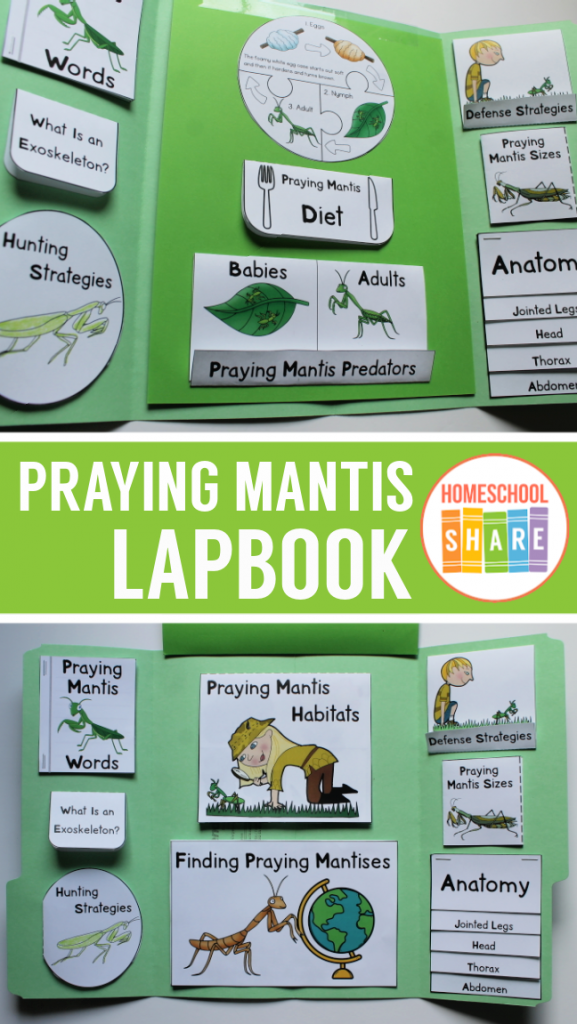
Praying Mantis Lapbook Lessons
Here are some sample lessons from the Praying Mantis Lapbook:
Praying Mantis Habitats
Praying mantises do not build homes, such as nests or hives, the way some other insects do. Instead, they live in trees, shrubs, flowers, or grass. Mantises find homes where they can hide or camouflage themselves. For example, the dead-leaf mantis looks like dried, crumpled leaves which help it blend in with the rotting leaves that are its home.
Praying Mantis Life Cycle
The three growth stages (egg, nymph, and adult) the mantis goes through are known as simple metamorphosis. They usually live for three to nine months.
1. Egg Stage
Around late summer, the abdomen of the female mantis is full of eggs. When she’s ready to find a mate to fertilize her eggs, she gives off a chemical called a pheromone. It’s like a perfume and, when a male mantis senses it with his antennae, he will know that the female mantis will welcome him. Once he knows it’s safe to approach her, he performs a little dance where he spreads his wings and curls his abdomen to get her attention. If the female likes what she sees, she will hold out her front legs which scientists think is a signal to let the male know that she will not hurt him. This is important because some female mantises will bite the head off the male if he gets too close and she’s not ready to mate.
About nine days after the mantises mate, the female will search for a stem or branch well above the ground to protect her eggs from predators. Once she finds the perfect spot, she hangs upside down from the branch and white foam that looks like whipped cream and made of protein starts to flow out from her ovipositor which is located at the very end of her abdomen. Her abdomen then moves in circles to form a soft egg case, called an ootheca, out of the foam. Then, she quickly lays her 50-300 eggs in this foam before it hardens. The hardened egg case is about the size and color of a walnut. This case serves as a safe home for her eggs. It can survive wind, snow, and rain. It also keeps out egg-eating enemies like ants and spiders. The female mantis makes several eggs cases before winter comes. Once she has laid her eggs, the female mantis’ job is done. She will never meet or raise her young. In fact, she will not live much longer after she’s finished making her last egg case.
2. Nymph Stage
In the spring, the days warm up which is the signal for baby mantises to push through slits located at the bottom of the egg case. These young mantises are called nymphs or mantids. They are no bigger than a mosquito. They look like tiny adult mantises but are the color of honey and have no wings. Once they’ve pushed out of the egg sac, the nymphs dangle upside down from thin threads then drop to the ground and run for shelter before any predators can spot them. Soon after, they shed their exoskeletons for the first time in order to grow. This is called molting. A nymph molts by hanging upside down from a plant stem. Its skin splits open and the nymph wiggles out of it. A nymph goes through six to ten molts, becoming larger each time, until it’s fully grown. The last time it molts, it will finally have fully formed wings. A young mantis is born knowing how to survive. Its front legs are ready to catch and hold prey. Its sharp mouth parts are ready to bite and chew. Before its first day is over, some nymphs will even eat their brothers and sisters if they’re hungry enough!
3. Adult Age
Despite its strong survival skills, many nymphs get eaten by predators like larger insects, spiders, and birds while others drown in spring rains. The nymphs who do manage to survive will reach adulthood in late summer when they will begin to look for mates to start the life cycle all over again.
To access all of the lessons in this Praying Mantis Lapbook, subscribe to Homeschool Share’s email list using the form in this post.
Praying Mantis Lapbook Printables
In addition to the research lessons, the file includes these mini-books for your student to create a Praying Mantis Lapbook:
- Praying Mantis Words (record new words and definitions)
- Praying Mantis Predators Matchbook
- Praying Mantis Diet Simple Fold Book
- Praying Mantis Life Cycle Puzzle
- Finding Praying Mantises Map
- What Is an Exoskeleton? Simple Fold Book
- Praying Mantis Habitats
- Praying Mantis Sizes Twice Folded Book
- Defense Strategies Matchbook
- Mantis Facts Simple Fold Book
- Hunting Strategies Simple Fold Book
- Praying Mantis Anatomy Layer Book
- Praying Mantis Diagram (Label a Praying Mantis)
Praying Mantis Lapbook Sample
Here is a Praying Mantis Lapbook sample to help you consider how to put together your own Praying Mantis Lapbook. This lapbook was made with one file folder and one center extension.
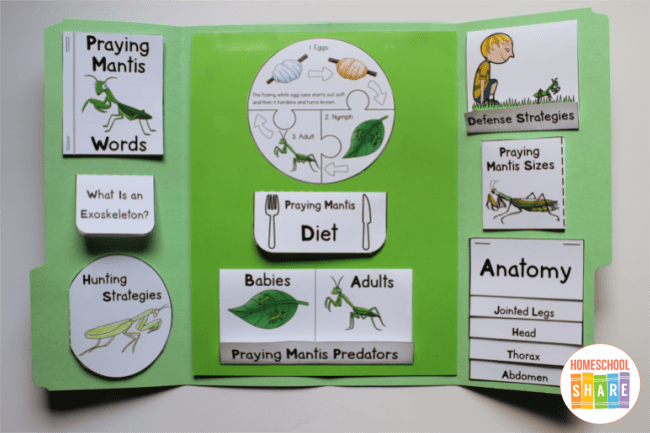
Note: The life cycle puzzle was scaled to 50% when printing.
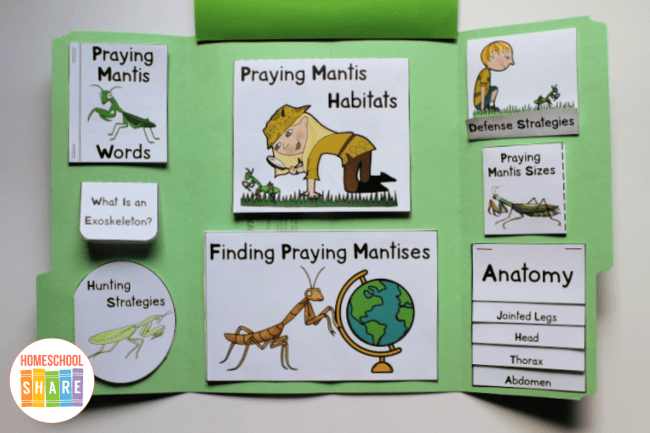
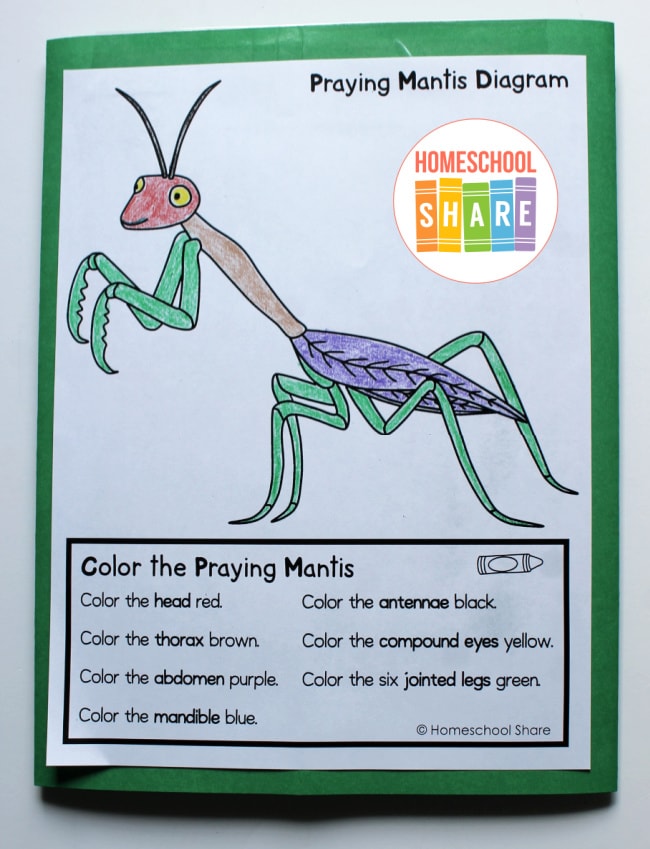
Praying Mantis Video
You can find dozens of great Praying Mantis videos. Here is one we used during our Praying Mantis study.
Learn about the Praying Mantis as a predator.
How to Get Started with Your Praying Mantis Lapbook
Follow these simple instructions to get started with the Praying Mantis Lapbook.
- If you want, go to your local library and check out books about praying mantises.
- Print the Praying Mantis Lapbook.
- Choose and prepare the mini-books you want to use with your student.
- Enjoy a week of reading and learning all about these fascinating insects!
Download Your Free Praying Mantis Lapbook
Use the form below to subscribe to the newsletter. Once you confirm, you’ll receive an email with the link to the lapbook. If you are already confirmed, simply enter your name and email address below, and you will receive an email with the link.
Learn About Other Insects
If you have a budding entomologist, consider using some of our other insect lapbooks.

